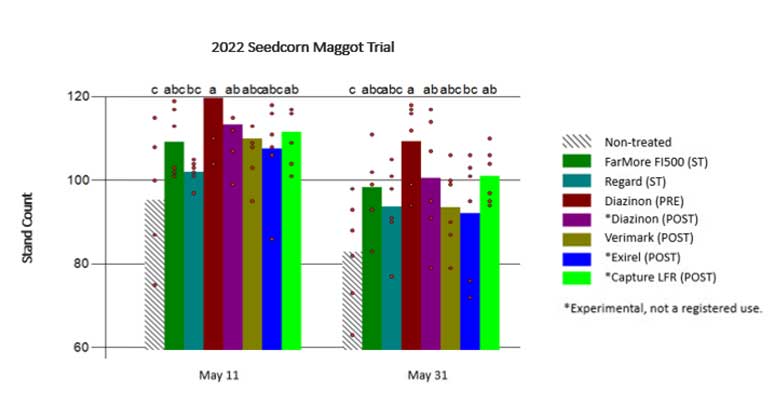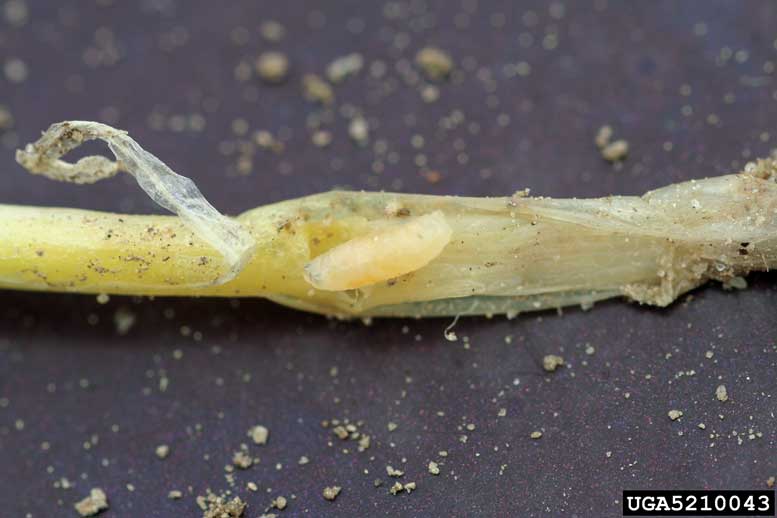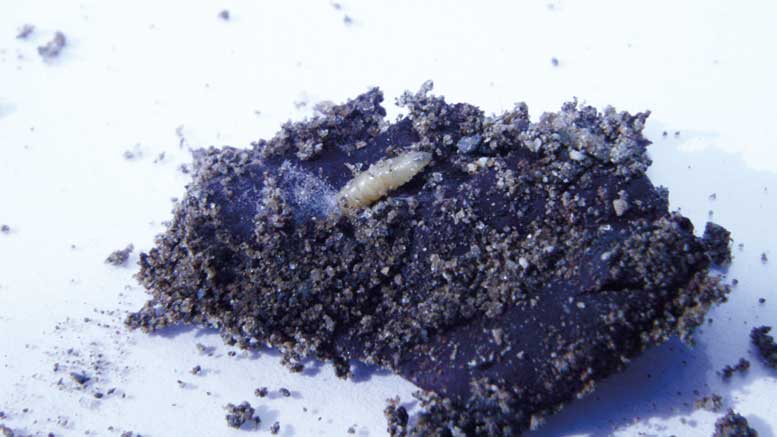|
Click to listen to this article
|
By Tim Waters and Carrie Wohleb, Washington State University Extension
Without the availability of Lorsban (chlorpyrifos) to control seedcorn maggot, onion growers are looking for alternatives. A 2022 research trial has put other options to the test and identified insecticides to manage this damaging pest.
Seedcorn maggots are the larvae of a small fly species (Delia platura). The first generation of this pest emerges from the soil as adult flies; they resemble small house flies. The flies mate, and then the females lay eggs on the soil or in plant residues in the soil. Each female lays about 270 eggs. The eggs hatch readily at temperatures as low as 50 degrees Fahrenheit, and they may only take a week or two to hatch. The emerging maggots feed on the tender tissues of germinating seeds and young seedlings. Later, they pupate to start the cycle again. Seedcorn maggots cycle through three to five generations per year.
Minimizing Damage Using Cultural Practices
Onion seedlings are most vulnerable to injury during growth stages from germination, flag leaf emergence, and up to emergence of the first true leaf, so seedcorn maggot larvae that hatch then are the most destructive to onions. Feeding injury during the most susceptible stages can result in significant stand loss and stunting, which can negatively impact onion bulb size and yield at harvest. In some cases, replanting may be necessary to achieve an acceptable crop.
Practices that promote rapid germination and emergence can reduce stand loss by shortening the window of greatest vulnerability to injury: 1) plant into moist (but not excessively wet) soil because onion seeds need adequate moisture to germinate and emerge; 2) delay planting until soils have warmed because germination is quicker at soil temperatures above 52 degrees Fahrenheit; and 3) deep planting can delay emergence, so a shallow depth of 0.25 inch to 0.75 inch is recommended for most soils, and up to 1 inch if moisture is limited.
Damage from seedcorn maggot feeding tends to be more extensive when there are a lot of organic residues like animal manure, green manure and stubble in the field. Adult flies are attracted to decaying matter and prefer to lay eggs in fields with residues. Incorporating residues into the soil to promote decomposition several weeks in advance of planting can be an effective cultural management practice because the residues should be mostly decayed and should attract fewer flies when it is time for planting.
Minimizing Damage Using Insecticides
Applying insecticides preventively, as a seed treatment or an in-furrow application, has proven to be the most reliable way to minimize damage from seedcorn maggot. Many onion growers were using Lorsban (chlorpyrifos) to control seedcorn maggot, but this product can no longer be used.
What are the next best options? In 2022, a trial was conducted in the Columbia Basin of Washington state to identify insecticides that can help onion growers control this pest.

2022 Seedcorn Maggot Insecticide Trial
The trial was planted in late March in Pasco, Washington. The experimental design was a randomized complete block with six replicates of seven insecticide treatments and a non-treated check. Application timing and method differed among treatments; ST = seed treatment, PPI = preplant banded and mechanically incorporated, POST = banded and watered in 10 days after planting. Some of the insecticides are not labeled for use on onions, or for the use described, but they were included in the trial to explore possible options for the future. Stand counts were done on May 11 and May 31 to assess treatment performance.
- Non-treated
- FarMore FI500 (ST)
- Regard (ST)
- Diazinon 600 at 102 fl. oz/acre (PPI)
- Diazinon 600 at 102 fl. oz/acre (POST) *not a labeled use
- Verimark at 10 fl. oz/acre (POST)
- Exirel at 18 fl. oz/acre (POST) *not a labeled use
- Capture LFR at 8.5 fl. oz/acre (POST) *not a labeled use
Results
The results of the 2022 trial demonstrate that onion growers have options to control seedcorn maggot in 2023 (Fig. 1).
Diazinon (diazinon) (IRAC Group 1) –This product led to the best stands in the trial when used at the highest labeled rate (102 fl. oz./acre) as a pre-plant application. The application after planting (not labeled) did not perform quite as well. The pre-plant application of diazinon is an option onion growers can use now, but it looks like diazinon has a limited future; it is not likely to be re-registered when it comes up for review by the EPA.
Capture LFR (bifenthrin) (IRAC Group 3) – This product performed well in the trial, but it is not registered for use on onions. Capture LFR will be included in a Western Region IR-4 trial in 2023 to gather data to support its registration for use on onions to control seedcorn maggot. It shows promise as a potential “rescue treatment” to control unexpected infestations or infestations that were not controlled with preventive pre-plant or at-plant insecticides. It is currently registered for use on crops like beans and peas, coriander and sweet corn, and can be applied pre-plant incorporated (PPI), at-planting, or as a pre-emergent (PRE) or foliar application.
FarMore FI500 (fungicides, thiamethoxam and spinosad) (IRAC GROUP 4A and 5) – This seed treatment demonstrated effective control of seedcorn maggot in this trial and in many previous trials conducted in the Columbia Basin. Spinosad is the heavy hitter in this one, but thiamethoxam assists. FarMore FI500 (with spinosad) will not be available in 2023 because Syngenta will no longer have access to spinosad, a Corteva product. However, onion growers can combine products to use the same set of active ingredients (see below).

Regard (spinosad) or Lumiverd (spinosad) (IRAC Group 5) – This seed treatment controls seedcorn maggot, but we recommend combining it with a thiamethoxam seed treatment (see below). Instead of Regard, onion growers can use Lumiverd (spinosad) in 2023.
FarMore FI400 (fungicides, thiamethoxam) + Lumiverd (spinosad) (IRAC Group 4A and 5) – FarMore FI500 (with spinosad) is no longer available, but onion growers can use FarMore FI400 + Lumiverd in 2023. Lumiverd is an important add-on to the seed treatment because thiamethoxam alone will not provide adequate control of seedcorn maggot under most situations. However, we recommend using FI400 (fungicides and thiamethoxam) rather than FarMore FI300 (just fungicides) in combination with Lumiverd (spinosad) for the previously mentioned reasons.
Pesticide Use Disclaimer
Some of the pesticides discussed in this report were tested under an experimental use permit granted by the Washington State Department of Agriculture. Application of a pesticide to a crop or site that is not on the label is a violation of pesticide law and may subject the applicator to civil penalties. In addition, such an application may also result in illegal residues that could subject the crop to seizure or embargo action. It is your responsibility to check the label before using the product to ensure lawful use and obtain all necessary permits in advance.

